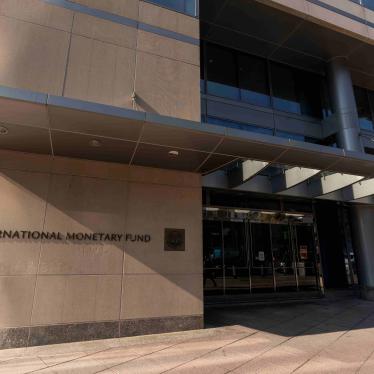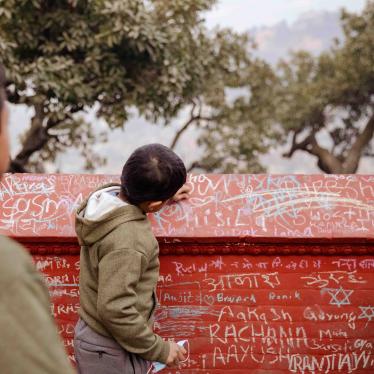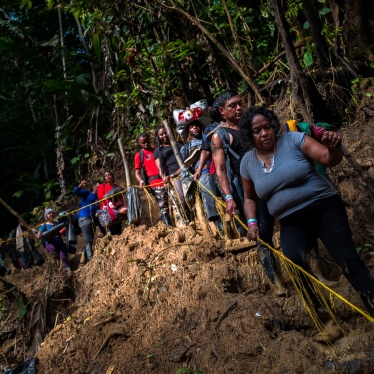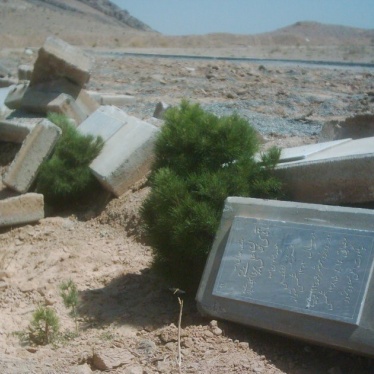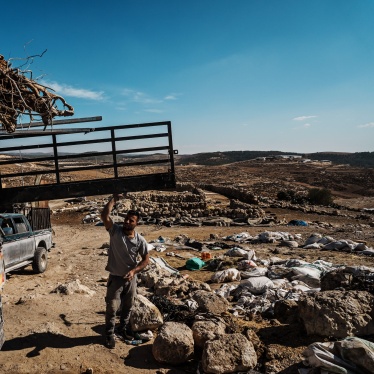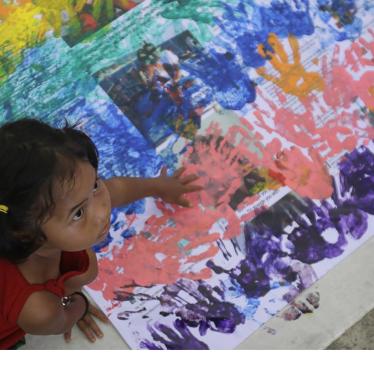Human Rights Watch has received information about human rights abuses against Dalits in virtually every sphere of life in Nepal, including marriage, religious practice, access to land, and access to education.1 This submission to the government’s 15th and 16th periodic report to the Committee documents continued conditions of oppression and abuse.
In the past, the CERD Committee has recognized the importance of eliminating caste-based discrimination in Nepal.2 It has noted that, despite government action to ban certain forms of discrimination, the caste system still takes a huge toll on Dalits in Nepal. The Committee has also called on the government of Nepal to improve its legislative framework ensuring equal rights for all and prohibiting discrimination against Dalits.
Within the Dalit community of Nepal, there are eight major caste groups and twenty-five identified sub-castes.3 Some NGOs estimate the Dalit population at 4.5 million, or 21 percent of Nepal's population.4 Despite their significant numbers, they continue to suffer from discrimination and human rights abuses by reason of their caste. Legal protections for Dalits have been poorly implemented, and discrimination against Dalits is still very much a part of everyday life in Nepal.
While oppression of Dalits has occurred in Nepal for centuries, the ongoing internal armed conflict between the government and Maoist rebels has led to increased attacks on Dalits by government forces. The government increasingly sees Dalit activism and Dalits themselves as tied to the insurgency, and Dalits have come under attack from government security forces because they are suspected of supporting the rebels.5
The legal framework: paper protections
On paper, Nepal’s legal protections against anti-Dalit discrimination are strong. The Constitution specifically forbids discrimination against Dalits:
No person shall, on the basis of caste, be discriminated against as untouchable, be denied access to any public place, or be deprived of the use of public utilities. Any contravention of this provision shall be punishable by law.6
In addition to the constitutional prohibition on caste-based discrimination, the government has also taken some legislative action to prohibit discrimination against Dalits. Under the Civil Liberties Act of 1954, unequal treatment of Dalits by the government is prohibited. Section 10A of the Civil Code also prohibits some forms of discrimination against Dalits, but excludes places of religious practice from the scope of the act.7
Despite these provisions, caste and caste-based discrimination remain a central feature of life and social interaction in Nepal, and the government regularly fails to prosecute individuals who engage in caste-based discrimination. On August 16, 2001, then-Prime Minister Sher Bahadur Deuba promised sweeping legislation to outlaw all forms of discrimination against Dalits and to create a national commission for the welfare of Nepalese Dalits. “It is our duty and responsibility to end this system that is discriminatory to our brothers and sisters,” the prime minister said.8
Although such a commission, the National Dalits Commission, has since been created, the legislation has yet to be passed. The legislation, the Bill to Uplift and Protect Dalits, was introduced in 2001, but, three years later, has yet to be enacted. In a comment on the prime minister’s speech that proved to be prescient, Dalit activist Kamala Hamachuri, of the Nepalese Dalit Service Association, remarked, “We have received many promises and assurances from politicians in the past, but there were never any deliveries. It takes more than promises to change the thinking and attitude of society.”9
Violence against Dalits
Dalits are victims of targeted attacks. Police officials often fail to investigate reports of violence against Dalits, and perpetrators of attacks on Dalits often go unpunished.10 Under Article 6 of the ICERD, parties to the convention are obligated to provide effective remedies for acts of racial discrimination, including violent attacks.
Slight infractions of caste boundaries can lead to violence. In October 2003, MB, a Dalit from Kantipur, was attacked by a man after she allegedly touched his wife at a local water tap. The man avoided being prosecuted for the attack by making a public apology and pledging not to engage in similar acts in the future.11
Another attack highlights the prevalence of racial and caste prejudices, in some cases even among Dalits of different caste stature. One such attack, in which both victim and attacker were Dalits, occurred in the city of Ramechhap in September 2003. After stopping to take a drink from a local spring, KD, 47, was attacked and severely beaten by a man of a higher caste and members of his family.12 The man had tried to stop KD and his family from taking water from the spring because he feared that KD, who came from a lower Dalit caste than he did, would contaminate the spring water by virtue of his lower-caste status.
Even a senior politician has been implicated in violence against Dalits. On October 21, 2003, a Member of Parliament from Saptari District in the Eastern Development Zone, allegedly beat 11-year-old Dalit youth and his mother, claiming that their animals were eating his crops.13 Four other upper-caste individuals also took part in the attack.
Social discrimination against Dalits
While new legislation protecting the rights of Dalits is welcome, the government has regularly failed to enforce existing legislation, including basic provisions of criminal law, to protect Dalits from abuse by members of the upper castes. Dalits are regularly subject to social exclusion. Dalits have been prohibited from entering upper-caste Hindu temples, and have been penalized for marrying above their caste.14 Dalits live in segregated neighborhoods, kept separate by both social and economic forces, from members of higher castes.15 Dalits are often forced to perform menial tasks, such as removing dead animals or cleaning human excreta, and are often punished if they refuse to do so. Even water wells are segregated by caste, and those Dalits who fail to abide by the rules of separation face severe retaliation.16 All such acts of discrimination and exclusion are prohibited under the ICERD, which obligates parties to the Convention to “pursue by all appropriate means and without delay a policy of eliminating racial discrimination.”17
Dalits are regularly segregated away from public facilities. In the Baniyar section of Bardiya district in the Mid Western Region of the country, Dalits were denied access to a public water tap, despite the fact that the majority of families in that neighborhood were lower caste.18 Dalits were thus placed at the mercy of upper-caste owners of private taps in order to gain access to clean drinking water. Upper caste tap owners have cursed and insulted Dalits before giving them access to their taps.
Conclusion
Dalits in Nepal face a powerful combination of social discrimination and violence that enforces their second-class status. Government inaction helps preserve this second-class citizenship: the Nepalese government often fails to prosecute those who engage in discrimination against Dalits and has yet to create a comprehensive plan for ensuring the rights of Dalits. In September 2001 the international community pledged to redouble its efforts to end race and caste-based discrimination, calling for an end to all such practices at the close of the United Nations World Conference Against Racism. The CERD Committee should push Nepal to live up to its obligations under the Convention on the Elimination of all forms of Racial Discrimination to end discrimination against Dalits and erase the caste lines that divide the people of Nepal.
Recommendations
The CERD Committee should:
- Urge the Nepalese government to pass comprehensive legislation prohibiting all forms of discrimination against Dalits, public and private.
- Consult with local Dalit groups on further positive steps that can be taken to end social and economic discrimination against Dalits.
- Investigate all cases of violence directed against Dalits, and prosecute the individuals responsible.
- Ensure that the government forces engaged in the internal armed conflict against insurgent forces not target Dalit civilians for attack.
1 Human Rights Watch would like to thank the Nepal-based Dalit NGOs that provided information for this report. Human Rights Watch would also like to thank Laurie Vasily, a US-based expert on Dalits in Nepal, for her assistance in providing information on cases of abuses against Dalits.
2 Committee on the Elimination of Racial Discrimination, Fifty-third session, Concluding Observations to the ninth to the thirteenth periodic reports of Nepal, CERD/C/53/Misc. 46, 20 August 1998.
3 Padmalal Bishwakarma, “Caste Discrimination and Untouchability Against Dalits in Nepal,” paper prepared by the Society for the Liberation of Oppressed Dalit Castes, Nepal, for the Global Conference on Caste Discrimination, New Delhi, March 1-4, 2001.
4 Ibid.
5 Human Rights Watch communications with Dalit activists, January 2004.
6 Constitution of the Kingdom of Nepal, 2047 (1990), Article 11(4).
7 Dr. Hari Bansh Tripathi, Fundamental Rights and Judicial Review in Nepal (Evolution and Experiments), Pairavi Prakashan, 2002, p. 141.
8 Binaj Gurubacharya, “Nepal bans bias against untouchables in move to end hindu caste system,” Associated Press, 17 August 2001.
9 Associated Press, “Nepal Untouchables Doubt Govt’s Vow To Ban Discrimination,” 25 August 2001.
10 Asian Legal Resource Centre, "Alternative report to the 16th periodic report of State Party Nepal to the Committee on the Elimination of Racial Discrimination," December 2003, p. 8.
11 “Public apology made for beating up Dalit woman,” Kantipur Post, October 25, 2003.
12 Tika Bhatta, “Dalits beat up family,” Kathmandu Post, September 13, 2003.
13 Human Rights Watch communication with expert on Dalits in Nepal, January 2003.
14 US Department of State, Bureau of Democracy, Human Rights and Labor, Human Rights Report, Country report on Nepal, 2002.
15 Berit Madsen, “The life of lower castes in the western part of Nepal,” MS Nepal.
16 Jana Utthan Pratisthan, Dalit in Nepal, April 2001, p. 25.
17 ICERD, Art. 2(1).
18 Dipendra Baduwal, “Dalit families forbidden to use public water-tap,” Kathmandu Post, December 20, 2002.
